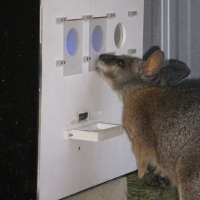Research shows wallabies lose on the pokies

(Phys.org) —Biologists have discovered that a wallaby's perception of colour is more similar to a dog than a quokka, sparking questions as to why marsupial colour vision has evolved so selectively.
By developing a pokies-like game for the wallabies, the research – recently published in PLOS ONE by Curtin University's Dr Wiebke Ebeling and colleagues – was able to determine exactly what the animals saw and how their colour perception differed from other species.
"We trained tammar wallabies to respond to different colour stimuli by pressing switches on an automated experimental setup, similar to a poker machine," Dr Ebeling said.
"The most remarkable result was the determination of the 'Neutral Point' which describes a single colour that to wallabies looks identical to white, where the animals cannot make up their mind which switch to choose. In the case of wallabies, this was a shade of cyan (greenish blue).
"The presence of a Neutral Point makes wallabies appear special among marsupials. Their vision is more similar to a dog or horse rather than other marsupials, even their close relative the quokka.
"This study has raised new questions as to why good colour vision evolves so selectively and should be beneficial to the quokka but not the wallaby."
Dr Ebeling said the team presented tammar wallabies with a choice between white and different yellows, greens and blues. When choosing the correct stimulus in the experiment, the wallaby would be treated with food, leading to an extremely accurate determination of the Neutral Point.
She said the presence of a Neutral Point, together with results from other colour-mixing and colour discrimination experiments, was typical for 'dichromats' - species with two colour-sensitive photoreceptor types in their retina. Whereas 'trichromats' like humans and other marsupials such as the fat-tailed dunnart, with one more photoreceptor type in their retinas, could not be confused as easily.
"The case of the wallaby is clear-cut now: it's a dichromat, but it still remains a mystery what exactly the additional photoreceptor in other marsupials is and why the wallaby should be the only one to miss it," Dr Ebeling said.
"This diversity will require more research by tracking down the elusive photoreceptor gene and examining the behavioural colour vision capabilities of other marsupials to confirm other species as trichromats."
She said behavioural experiments allowed shy and night-active species like the tammar wallaby to participate on their own terms and reveal their perception of colours.
"Our wallabies learned quickly and seemed to enjoy working on the machine and often did not bother actually eating the food - they just played for the fun of it," Dr Ebeling said.
More information: Ebeling W, Hemmi JM (2014). "Dichromatic Colour Vision in Wallabies as Characterised by Three Behavioural Paradigms." PLoS ONE 9(1): e86531. DOI: 10.1371/journal.pone.0086531
Journal information: PLoS ONE
Provided by Curtin University




















